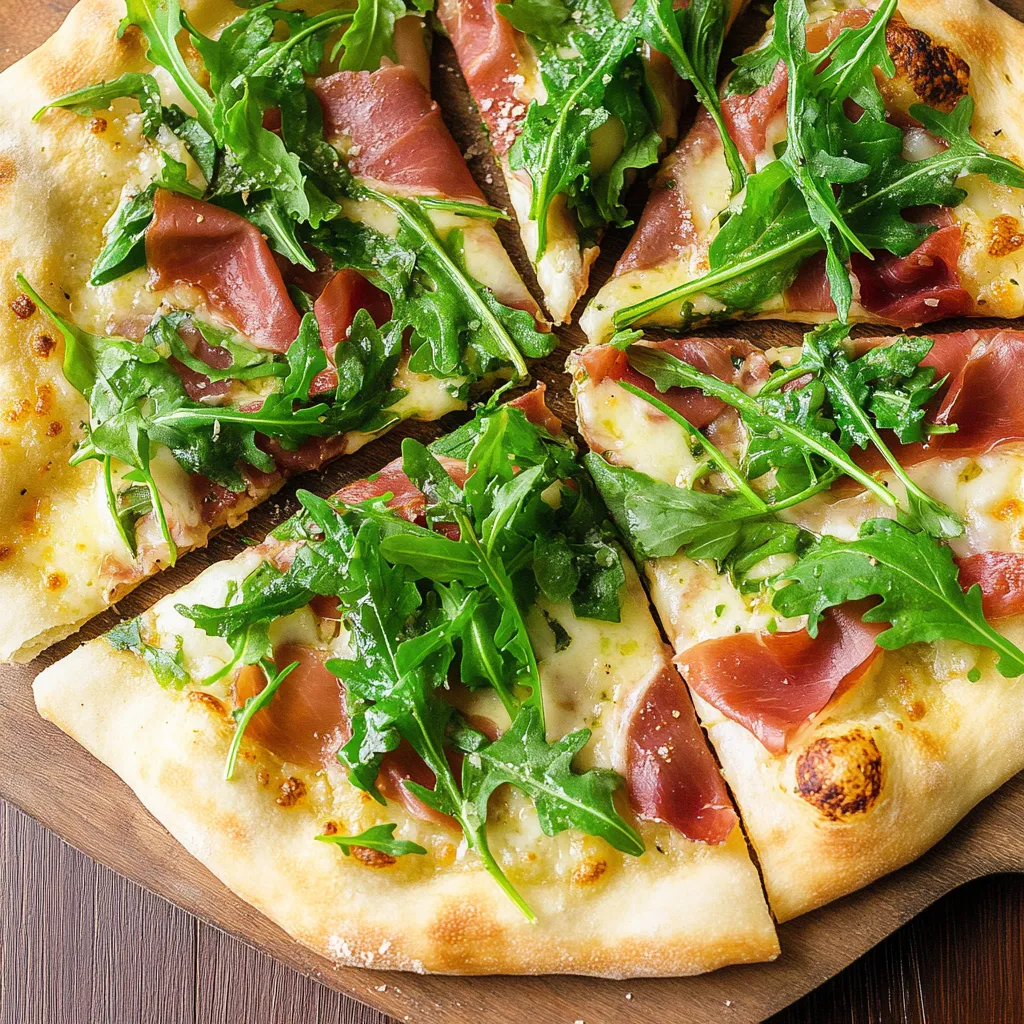 Pin it
Pin it
This arugula and prosciutto pizza transforms an ordinary weeknight dinner into something that feels restaurant-worthy without all the fuss. The combination of peppery arugula, salty prosciutto, and melted cheese creates layers of flavor that make each bite interesting. What makes this pizza special is how the fresh arugula salad gets added right at the end, so you get that perfect contrast between the hot, crispy pizza base and the cool, bright greens on top.
I discovered this combination at a little Italian place years ago and knew I had to recreate it at home. The first time I made it, I was amazed at how something so simple could taste so sophisticated. My family now requests this pizza regularly, especially during warmer months when we want something that feels fresh but still hearty.
Essential Ingredients and What to Look For
- Pizza dough (8 oz ball): Store-bought works perfectly fine, but make sure it's at room temperature for easier stretching; look for dough that feels smooth and elastic, not sticky or overly wet
- Baby arugula (4-5 oz): Choose leaves that look bright green and perky, avoiding any that are yellowing or wilted; baby arugula works better than regular because the smaller leaves don't overpower each bite
- Prosciutto (3-4 oz): Get it sliced thin from the deli counter if possible, and make sure there's paper between each slice so they don't stick together in one impossible-to-separate clump
- Low-moisture mozzarella cheese: Skip the pre-shredded bags and grate a block yourself; the texture and melting quality is so much better, and it doesn't have those anti-caking agents
- Extra virgin olive oil (3 tablespoons): Use something with good flavor since this becomes your pizza sauce; a robust, fruity oil makes a noticeable difference in the final taste
- Fresh garlic (2 cloves), shallot (1 small), fresh rosemary (1 teaspoon minced): These create the aromatic base; make sure your garlic is firm and your rosemary still smells strongly when you rub it between your fingers
- Fresh lemon juice and Parmesan cheese: For finishing touches that brighten and sharpen all the other flavors
Step-by-Step Cooking Instructions
- Preheat your baking steel or pizza stone:
- Place it on the top rack of your oven and heat to 500°F for a full hour before you plan to cook. This step is crucial because the intense heat from below is what gives you that crispy bottom crust that can support all the toppings without getting soggy. If you don't have a baking steel, use an upside-down sheet pan, though the results won't be quite as crispy.
- Prepare your aromatic oil base:
- In a small bowl, combine 3 tablespoons of olive oil with 2 minced garlic cloves, 1 finely minced shallot, and 1 teaspoon of minced fresh rosemary. Mix this thoroughly and let it sit while you prepare everything else so the flavors can meld together. The oil should smell incredibly fragrant and almost like a liquid herb garden.
- Get your cheese and toppings ready:
- Grate your mozzarella using the large holes of a box grater, and have your Parmesan ready for a light dusting. Tear your prosciutto slices into smaller, irregular pieces - this prevents long strips from sliding off when you bite into the pizza, and creates more edges that will get crispy in the oven.
- Stretch your pizza dough:
- On a lightly floured surface, gently stretch your room-temperature dough into a roughly 12-inch circle. Don't worry about perfect circles; rustic shapes often look more appealing anyway. Transfer the stretched dough to a pizza peel dusted with semolina flour, or place it on parchment paper if you don't have a peel.
- Assemble the pizza efficiently:
- Working quickly so the dough doesn't stick to your peel, spread the herb oil mixture evenly across the surface using the back of a spoon, leaving about a half-inch border for the crust. Sprinkle the grated mozzarella evenly over the oil, then add a light dusting of Parmesan. Distribute the torn prosciutto pieces across the surface, gently pressing them into the cheese so they'll stay put.
- Launch and bake:
- Give your assembled pizza a gentle shake on the peel to make sure it's not stuck, then slide it onto your preheated baking steel. Bake for 2-3 minutes, rotate the pizza 180 degrees for even cooking, then bake another 2 minutes. Turn on your broiler and broil for 1 minute to get those beautiful golden-brown spots and crispy prosciutto edges.
- Prepare the arugula while pizza bakes:
- In a medium bowl, toss 4-5 ounces of baby arugula with 1 tablespoon of fresh lemon juice, a pinch of salt, and freshly ground black pepper. The arugula should be lightly dressed but not drowning in lemon juice.
- Final assembly and serving:
- The moment your pizza comes out of the oven, immediately top it with the dressed arugula while the pizza is still blazing hot. The heat will barely wilt the outer edges of the greens while keeping them mostly fresh and crisp. Slice immediately and serve while the contrast between hot pizza and cool greens is at its peak.
 Pin it
Pin it
The secret to getting perfectly crispy prosciutto is all in how you arrange it on the pizza. Instead of laying the pieces completely flat, I like to create little peaks and valleys by twisting or folding the pieces slightly. This exposes more surface area to the intense heat of the broiler, which means more of those delicious crispy edges that add such great texture contrast to each bite.
Getting the right balance of oil for the base takes some practice. You want enough to create flavor and help everything meld together, but not so much that your pizza becomes greasy. I learned this the hard way after making a few pizzas that were delicious but left oil puddles on the plate. The herb oil should coat the dough evenly but not pool anywhere.
The timing of adding the arugula is absolutely critical to this recipe's success. Add it too early and it wilts completely into sad, dark green bits. Add it at exactly the right moment when the pizza is still hot from the oven, and you get this perfect combination where the leaves stay mostly crisp but pick up just enough heat to release their peppery flavor. This technique works for any pizza where you want to add fresh greens as a finishing touch.
Temperature control becomes really important when you're working with delicate ingredients like prosciutto and fresh greens. The high heat that makes the crust crispy can easily burn thin slices of meat or completely wilt your carefully prepared salad. I've found that the broiler step at the end is what really makes the difference - it gives you those gorgeous brown spots and crispy meat edges without overcooking everything else.
One thing that surprised me when I first started making this pizza regularly was how much the quality of your olive oil matters. Since there's no traditional tomato sauce, the herb oil really becomes the flavor foundation of the entire pizza. I used to think any olive oil would work fine, but using a really good extra virgin olive oil with fruity, peppery notes elevates the entire dish. It's worth spending a little extra on a bottle you'd be happy to dip bread into.
The first time I made this pizza, I underestimated how quickly everything would wilt once I added the arugula to the hot surface. I had prepared this beautiful, carefully dressed salad and watched it transform into something that looked more like cooked spinach within seconds. Now I know that the arugula should look almost overdressed when you first toss it, because much of that lemon juice gets absorbed by the heat and the leaves themselves. My kids actually prefer when I add a tiny bit of honey to the lemon juice mixture - it balances the peppery arugula and makes the whole pizza more approachable for younger palates.
After making this pizza dozens of times, I've come to appreciate how it bridges the gap between comfort food and something that feels special enough for company. The technique is straightforward enough for a weeknight, but the flavors are sophisticated enough that guests always ask for the recipe. What I love most is how the arugula adds this fresh, almost cleansing element that keeps the rich cheese and salty prosciutto from feeling too heavy. It's become my go-to pizza when I want to feel like I'm eating something healthy while still indulging in one of my favorite comfort foods.
Frequently Asked Questions
- → Can I make the pizza dough ahead of time?
- Yes, making the dough a day ahead actually improves the flavor and makes it easier to stretch.
- → What can I use instead of a pizza stone?
- You can use a large baking sheet or follow the instructions from your pizza dough recipe instead.
- → How do I prevent the pizza from sticking to the peel?
- Dust the peel generously with semolina flour and shake the pizza before launching to make sure it moves freely.
- → Can I substitute the prosciutto with something else?
- Yes, you can use pancetta, bacon, or even grilled chicken for a different protein option.
- → When should I add the arugula to the pizza?
- Always add the dressed arugula after baking to keep it fresh and prevent it from wilting in the oven.
- → How thin should I stretch the pizza dough?
- Stretch it until the center is thin enough to see light through, with thicker edges for the crust, about 12-14 inches across.
